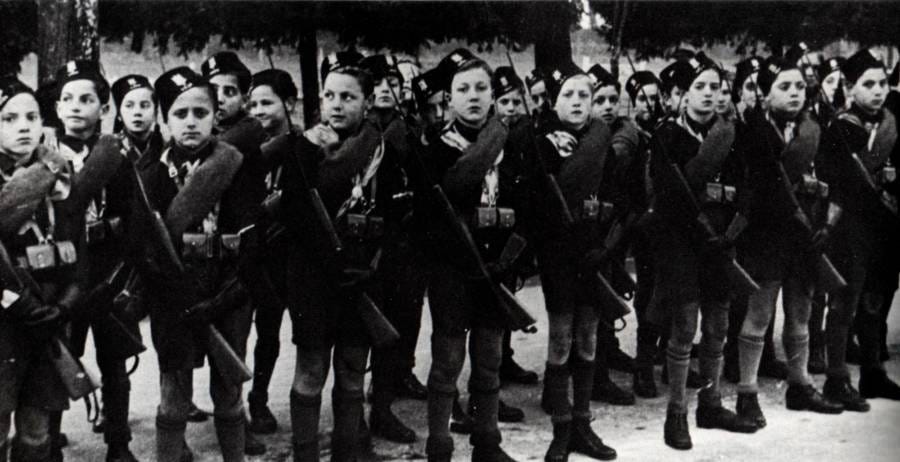A few weeks ago, I discovered my grandfather’s 10-part series about his escape from Europe in 1939. The articles, which were all published in the UCLA Daily Bruin between March-April 1940, include several excerpts from my grandfather journal, which is — sadly — lost.
As I read through this new evidence, what struck me was Opapa’s description of militarization in Europe. Take, for example, Opapa’s comments upon his arrival Italy in April 1939, just after the Italian invasion of Albania. These are notes from Opapa’s travel notebook, which is excerpted in his article:
Soldiers are getting on the train in every station. Grey uniform, feather on the hat. A word is often mentioned: “mobilitazione.” That fog down there is so thick and smooth, and we are going down, right into it. It has no end. Little black points are floating on it. I can’t take my eyes off: it is the ocean. There are enormous Mussolini quotations on every wall that can be seen from the train. The most frequent is: “Credere, obedire, combattare.” Believe, obey, fight. Haven’t I been taught more or less of the same thing?
George Gerbner, “15,000 Miles to U.C.L.A.,” Part 3, UCLA Daily Bruin, March 11, 1940
I find this passage to be fascinating: first, the details. The “grey uniform, feather on the hat” helps me envision the scene. Second, Opapa’s first-ever view of the ocean — a moment that was clearly remarkable and profound — is sandwiched between descriptions of militarization. Before he arrives, he is surrounded by soldiers entering the train; and afterwards, as he enters Trieste, he sees Mussolini quotes decorating the walls. And he wonders whether he, too, has been trained to “believe, obey, [and] fight.”
Opapa’s next article goes into further detail about militarization in Italy, as well as the mindset that produces militarization. “Italy was carring on wars for five years,” he writes, quoting Mussolini again: “War alone keys up all human energies to their maximum tension and sets the searl of nobility on those people who have the courage to fact it.” Chilling.
Opapa was horrified by the warlike mentality, which contrasted with the beauty of so many Italian sites. “The view from Venice’s Campanile and Florence’s Palazzo Vecchio…was just the same as centuries ago,” he wrote. “Up there I had the feeling of being above not only the lagunas and palazzos, but above time, headlines, glaring Mussolini quotations on the walls.”
Once he returned to the streets, however, that sense of awe and wonder was replaced by foreboding:
Descending, on the streets of Florence I saw the “Balilla” troops, children of eight years marching in uniform with their eight year old commander, and training to jump over a sharp knife, helpf by the cheif commander of ten years. I couldn’t keep smiling any longer.
George Gerbner, “15,000 Miles to U.C.L.A.,” Part 4, UCLA Daily Bruin, March 14, 1940
I thought, perhaps, Opapa had been exaggerating a bit. Troops with eight year olds, led by a ten year old? But then I found a photograph of the Balilla troops, and if anything, some look younger than 8.
What Opapa was seeing and describing was the highly-developed process of militarization that created a warlike mentality of hyper-nationalism. I supposed I shouldn’t be so surprised, given that this was fascist Italy in 1939 — but I am. I think what is so striking how omnipresent the militarization was: children with rifles, graffiti on the walls, soldiers walking down the street and traveling in the trains. It was inescapable, and unavoidable.
This overwhelming process of militarization led to a general feeling of futility amongst average people:
The public was given the problem together with the accomplished solution. There was no chance of taking parts; the people are not supposed to do so. (“Believe, obey, fight.”) ‘The big fish swallows the little fish,’ said a young man matter-of-factly in a motorboat “bus” on the Grand Canal.
George Gerbner, “15,000 Miles to U.C.L.A.,” Part 4, UCLA Daily Bruin, March 14, 1940
The militarization continued as Opapa rode the train into France:
Trains were coming from Paris jammed with soldiers and tanks I wrote in my notebook, ‘Arming everywhere feverishly. Can they afford now NOT to have a war…?”
George Gerbner, “15,000 Miles to U.C.L.A.,” Part 4, UCLA Daily Bruin, March 14, 1940
“Can they afford now NOT to have a war…?”
It’s a thought-provoking line, and it made me realize how the actual act of warfare is almost a post-script. The creation of war is a years-long process, which includes funding, planning, indoctrination, and storytelling: convincing enough people that war can be the only answer.
***
Nuts to crack:
I’m trying to figure out Opapa’s stance on the war, and how it changed. He seems to have had pacifist leanings in 1939-1940.
Was there a Hungarian equivalent to the Italian Balilla troops?





Fascinating. ... and depressing as well.